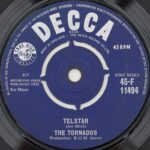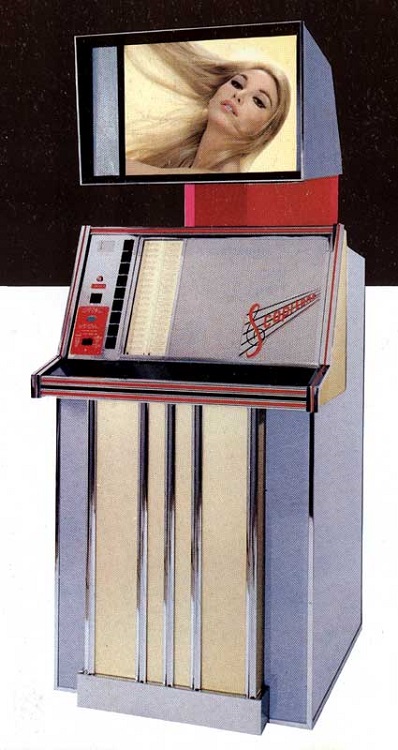 It’s not the first single I ever bought, but this is my first memory of the combination of music and film, a couple of decades before the pop video and MTV took hold. Where do you think the least likely place would be to see (and hear, because you certainly bloody heard it) a Scopitone film clip of a huge sixties tune. An instrumental that managed to imprint itself on my consciousness because it’s a cracking, ground-breaking tune and for another unrelated reason I’ll revisit later. That place was a pit canteen on the east coast of Fife and the tune was “Telstar” by The Tornados. Unlikely? Maybe, but true nevertheless.
It’s not the first single I ever bought, but this is my first memory of the combination of music and film, a couple of decades before the pop video and MTV took hold. Where do you think the least likely place would be to see (and hear, because you certainly bloody heard it) a Scopitone film clip of a huge sixties tune. An instrumental that managed to imprint itself on my consciousness because it’s a cracking, ground-breaking tune and for another unrelated reason I’ll revisit later. That place was a pit canteen on the east coast of Fife and the tune was “Telstar” by The Tornados. Unlikely? Maybe, but true nevertheless.
It seems unlikely now, but at that time, nearly sixty years ago, the Fife coast between Kirkcaldy and Methil was a string of mines ripping coal out from underneath the River Forth. The Michael Colliery in East Wemyss was just one of those mines, providing work for the community and blackening the coastline. South-west of Kirkcaldy and north-east of Methil the beaches were golden; between those two towns, the coast was a uniform black and it’s just beginning to recover now, fifty years after the mines closed.
The villages along this stretch of coast, Dysart, West Wemyss, Coaltown of Wemyss, East Wemyss, Buckhaven (Buckhyne if you’re a true Fifer) and Methil were mining communities and the pit canteen was as much of a social hub as the local pub or club. I don’t know about The Frances in Dysart (or The Dubbie as we knew it) or The Wellesley in Buckhaven, but The Michael in the early sixties had a Scopitone video jukebox and it was the eighth wonder of the world. My introduction to this wonderful device changed my life forever.
In a small village and tight-knit community, news spreads quickly and the installation of a jukebox that showed films had as much of an impact as the Cuban missile crisis. Security at the Michael site was non-existent and anyone could walk in to the canteen, so why wouldn’t you just do it, even at the age of seven. Obviously, I didn’t have any money to feed the Scopitone beast when I made my first visit to its lair, but it didn’t matter; someone with incredibly good musical taste had already fed the monster. I looked the Scopitone in the eye and waited for a reaction.
Exciting doesn’t really do it justice; the sound that came out of that beast was breath-taking and it was combined with film of The Tornados and a satellite launch. Like most jukeboxes, the tube amplifier was powerful and definitely not subtle. It was all about excitement and maximum impact; combine the pulsing sci-fi sound effects and the ascending organ pattern of the intro leading up to the eruption of the main melody with a shot of a Saturn I thrusting upwards into space spliced with shots of the band performing on 16mm colour film and you have something that, for me, was literally out of this world. From that moment on I was hooked. I liked the pop music of the time when I got to hear it on the radio or on a small black and white TV, but this was something completely different; it was loud, it was visceral and impossible to ignore. I knew that I wanted more of it, and I still do.
It was only years later that I understood the significance of Telstar’s creator, Joe Meek, in pop history, but I knew at the time that I had heard a glorious noise and I was desperate to hear more of the same.

Le Scopitone was a French invention that achieved limited success despite its great potential as a promotional tool. It was bulky but reasonably reliable, although the number of songs was limited compared to an audio-only jukebox and production costs were obviously much higher where film was involved. Also, Scopitone never managed to lure the real superstars of the time to the format. It managed to survive until 1978 (only three years before the official launch of MTV) when it succumbed to the new, more cost-effective, video tape. I hope Le Scopitone had the same effect on others as it had on me.
Let’s get back to “Telstar” and the other association that explains why I love this tune so much. From about the age of five, my dad took me to Bayview (where the terraces were made of railway sleepers and gravel, with the odd crush barrier) to watch our local team East Fife, hoisting me over the turnstile so it wouldn’t register and he wouldn’t have to pay for me. A huge part of the ritual is applauding your team on to the pitch as the run-on music plays and you can probably guess by now what the run-on music was at Bayview. Fifty-five years and more (and a few relocations) have passed since then, but my team is still East Fife and they still run on to “Telstar” at New Bayview on the banks of The Forth. Some things don’t need to change or be improved.
And I still love to listen to “Telstar”, preferably my 7” vinyl copy. The anticipation as the stylus touches down and, the crackles and scratches and the rush as the intro builds up all take me back to that day in a pit canteen in East Wemyss, a lifetime ago.
Finally, a couple of pieces of trivia for you. The legendary Clem Cattini played drums on “Telstar” and George Bellamy (father of Muse’s Matt) played rhythm guitar – did you ever wonder where “Knights of Cydonia” came from?
I’ve got to be honest and say I’ve never been able to get my head round this one; why do musicians (particularly guitarists) trash their instruments? I mean when did you ever see a conductor shred his baton or a ventriloquist decapitate his dummy as a finale?
It’s all Pete Townsend’s fault because he smashed up a Rickenbacker guitar in September 1964 and claimed it was part of his manifesto as a disciple of auto-destructive art; so what’s that funny smell? I mean it’s not possible that it was just a bit of stage business designed to create a buzz and get people talking about The Who, is it? So he then spent years destroying guitars (which were more often than not cobbled together from previously-trashed instruments). Obviously, Keith Moon didn’t need any encouragement to embrace this destructive trend, but that’s another story (actually, it’s several other stories).
So, who’s next? Someone who didn’t need to resort to any of that nonsense, that’s who; James Marshall Hendrix. This was a man who didn’t need any gimmicks, but somehow felt the need to show how natural his ability was by playing with his teeth and behind his head. So when he followed The Who on the bill at Monterey Pop, he had to go one higher so, obviously, he sprayed his Stratocaster with lighter fuel and set fire to it. As cremation attempts go it was about as successful as Phil Kaufman’s efforts at Joshua Tree, but everyone was talking about Jimi Hendrix and the imitators were queuing up. Ritchie Blackmore, master of subtlety, pretty soon added Stratocaster destruction to his palette of sophisticated onstage techniques.
If you’re looking for some truly bizarre instrument abuse, then Keith Emerson’s your man. His big turn in the ‘70s was sticking knives into his organ (his Hammond organ, keep it clean) but unfortunately it always survived to inflict more prog-rock torture on unsuspecting loon-panted male adolescents. Even the punks got in on the act. One of the most iconic album covers of all time has a cover picture of a very angry Paul Simonon trying to demolish a Rickenbacker bass. Now, I don’t know about you but I’ve played a Rickenbacker bass and they’re heavy and built to withstand everything short of a nuclear holocaust. By the time he’d finally trashed it, Pennie Smith had got the original film developed and printed and the rest of The Clash were halfway to the next gig. Almost inevitably, Kurt Cobain had to get in on the act as well, extending his self-loathing to his guitars during Nirvana gigs in the ‘90s.
Has anyone noticed yet what all of these musical vandals have in common? You got it, that Y chromosome; it’s a macho thing, isn’t it? It’s also an insult to anyone who ever worked hard and saved hard to buy their guitars, drums and keyboards to see performers destroying instruments just to wind up an audience. Here’s an idea; why don’t we introduce fines for this offence the way they do for racquet abuse in tennis. Not looking so smug now are we, Matt Bellamy?
And what if Townsend smashed the first guitar because he didn’t realise the roof was so low?


